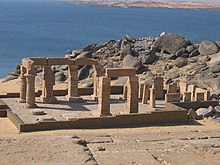203:
191:, which like the courtyard beyond is also free standing. The courtyard is surrounded by six columns and eight statue pillars. The entrance to a peristyle court "is decorated with colossal Osiris statues." The rear portion of the building which is 43 m in depth was carved out of rock and follows the structure of Abu Simbel with a pillared hall featuring two rows of three statue pillars and, curiously, four statue recesses, each with divine triads along the sides. Beyond the hall lay the hall of the offering table and the barque chamber with four cult statues of Ptah, Ramesses, Ptah-Tatenen and Hathor carved out of the rock.
218:
34:
234:
60:
246:
53:
202:
177:
233:
217:
397:
310:
Dieter Arnold, Nigel
Strudwick & Sabine Gardiner, The Encyclopaedia of Ancient Egyptian Architecture, I.B. Tauris Publishers, 2003. p.98
441:
52:
180:, sections of the free-standing portion of this temple were dismantled and they have now been reconstructed at the site of
245:
338:
287:
451:
266:
112:
436:
184:. Most of the rock cut temple was left in place and is now submerged beneath the waters of the Nile.
224:
33:
158:
446:
188:
8:
456:
430:
412:
399:
252:
181:
79:
39:
176:
During the building of the Aswan dam project in the 1960s, as part of the
142:
319:
Nicolas Grimal, A History of
Ancient Egypt, Blackwell Books, 1992. p.260
209:
339:"Francis Frith (1822-98) - Another view of the temple of Gerf-Hossayn"
288:"Francis Frith (1822-98) - Another view of the temple of Gerf-Hossayn"
38:
The freestanding courtyard of Gerf
Hussein temple, reconstructed at
166:
187:
An avenue of ram-headed sphinxes led from the Nile to the first
170:
154:
150:
146:
102:
162:
25:
153:. Situated on a bank of the Nile some 90 km south of
239:
Somewhat "squat" statue of
Ramesses II in the courtyard
208:
The Temple of Ptah seen from the Nile, 2 January 1960,
178:
International
Campaign to Save the Monuments of Nubia
173:, and associated with Ramesses, 'the Great God.'"
428:
361:Arnold, Strudwick & Gardiner, op. cit., p.99
141:, or 'House of Ptah') was dedicated to pharaoh
59:
32:
157:, it was partly free-standing and partly
127:Partially reconstructed, some submerged
429:
388:Arnold, Strudwick & Gardiner, p.99
370:Arnold, Strudwick & Gardiner, p.99
13:
442:Relocated monuments of Lower Nubia
14:
468:
244:
232:
216:
201:
58:
51:
382:
373:
364:
355:
331:
322:
313:
304:
280:
267:List of ancient Egyptian sites
223:Painting inside the temple by
1:
273:
269:, including sites of temples
16:Archaeological site in Egypt
7:
260:
113:Nineteenth Dynasty of Egypt
10:
473:
194:
123:
118:
108:
98:
93:
85:
75:
46:
31:
24:
161:. It was dedicated to "
452:Rock-cut architecture
413:23.2833°N 32.9000°E
409: /
137:(in Ancient Egypt:
21:
67:Shown within Egypt
19:
159:cut from the rock
145:and built by the
131:
130:
464:
437:Egyptian temples
424:
423:
421:
420:
419:
418:23.2833; 32.9000
414:
410:
407:
406:
405:
402:
389:
386:
380:
377:
371:
368:
362:
359:
353:
352:
350:
349:
335:
329:
326:
320:
317:
311:
308:
302:
301:
299:
298:
284:
248:
236:
220:
205:
62:
61:
55:
36:
22:
18:
472:
471:
467:
466:
465:
463:
462:
461:
427:
426:
417:
415:
411:
408:
403:
400:
398:
396:
395:
393:
392:
387:
383:
378:
374:
369:
365:
360:
356:
347:
345:
337:
336:
332:
327:
323:
318:
314:
309:
305:
296:
294:
286:
285:
281:
276:
263:
256:
249:
240:
237:
228:
221:
212:
206:
197:
71:
70:
69:
68:
65:
64:
63:
42:
27:
17:
12:
11:
5:
470:
460:
459:
454:
449:
444:
439:
391:
390:
381:
372:
363:
354:
330:
321:
312:
303:
278:
277:
275:
272:
271:
270:
262:
259:
258:
257:
250:
243:
241:
238:
231:
229:
222:
215:
213:
207:
200:
196:
193:
133:The temple of
129:
128:
125:
121:
120:
116:
115:
110:
106:
105:
100:
96:
95:
91:
90:
87:
83:
82:
77:
73:
72:
66:
57:
56:
50:
49:
48:
47:
44:
43:
37:
29:
28:
15:
9:
6:
4:
3:
2:
469:
458:
455:
453:
450:
448:
445:
443:
440:
438:
435:
434:
432:
425:
422:
385:
379:Grimal, p.260
376:
367:
358:
344:
340:
334:
328:Grimal, p.260
325:
316:
307:
293:
289:
283:
279:
268:
265:
264:
254:
253:Nubian Museum
247:
242:
235:
230:
226:
225:David Roberts
219:
214:
211:
204:
199:
198:
192:
190:
185:
183:
179:
174:
172:
168:
164:
160:
156:
152:
149:, Viceroy of
148:
144:
140:
136:
126:
122:
117:
114:
111:
107:
104:
101:
97:
92:
88:
84:
81:
78:
74:
54:
45:
41:
35:
30:
23:
394:
384:
375:
366:
357:
346:. Retrieved
342:
333:
324:
315:
306:
295:. Retrieved
291:
282:
186:
182:New Kalabsha
175:
138:
135:Gerf Hussein
134:
132:
80:New Kalabsha
40:New Kalabsha
20:Gerf Hussein
447:Ramesses II
416: /
143:Ramesses II
431:Categories
404:32°54′00″E
401:23°17′00″N
348:2022-02-04
343:www.rct.uk
297:2022-02-04
292:www.rct.uk
274:References
119:Site notes
124:Condition
261:See also
255:in Aswan
139:Per Ptah
76:Location
26:Per Ptah
251:At the
167:Tatenen
165:, Ptah-
109:Periods
99:Builder
94:History
227:(1838)
210:UNESCO
195:Images
171:Hathor
89:Temple
189:pylon
155:Aswan
151:Nubia
147:Setau
103:Setau
457:Ptah
169:and
163:Ptah
86:Type
433::
341:.
290:.
351:.
300:.
Text is available under the Creative Commons Attribution-ShareAlike License. Additional terms may apply.





